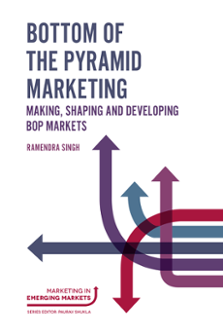
Index
Bottom of the Pyramid Marketing: Making, Shaping and Developing BoP Markets
ISBN: 978-1-78714-556-6, eISBN: 978-1-78714-555-9
Publication date: 3 December 2018
Citation
(2018), "Index", Singh, R. (Ed.) Bottom of the Pyramid Marketing: Making, Shaping and Developing BoP Markets (Marketing in Emerging Markets), Emerald Publishing Limited, Leeds, pp. 213-219. https://doi.org/10.1108/978-1-78714-555-920181013
Publisher
:Emerald Publishing Limited
Copyright © 2019 Emerald Publishing Limited
INDEX
Note: Page numbers followed by bold, italics and ‘n’ refers to tables, figures and footnotes respectively.
- Prelims
- Part I: Markets and Marketing at BOP: Where We are and What We Know
- Chapter 1 Evolving and Expanding Marketing to Address Challenges and Opportunities in BoP Markets: Looking Back and Forward
- Chapter 2 Making Markets ‘Worth the Effort’ at the Bottom of the Pyramid
- Chapter 3 A Qualitative Study on the Survival Strategies of Retailers in BoP Markets
- Chapter 4 Beyond the BoP: A Look into Alternative Domain
- Part II: Future of Research on BOP markets
- Chapter 5 Designing Solutions for the Low Income Consumer Markets: Four Schools of Thought
- Chapter 6 A Conceptual Model of Pro-poor Innovation Adoption in the BOP and Subsistence Marketplaces
- Chapter 7 Reflections from a Periodic Market in Rural India
- Part III: Lessons for Marketers
- Chapter 8 Bottom of the Pyramid Marketing: Examples from Selected Nigerian Companies
- Chapter 9 Profitability in Rural Bottom of the Pyramid (BoP) Markets from a Business Perspective: Evidence from Sri Lanka
- Chapter 10 Developing Capabilities and Freedoms at the Base of the Pyramid
- Chapter 11 Exploring the Urban BoP Market
- Index